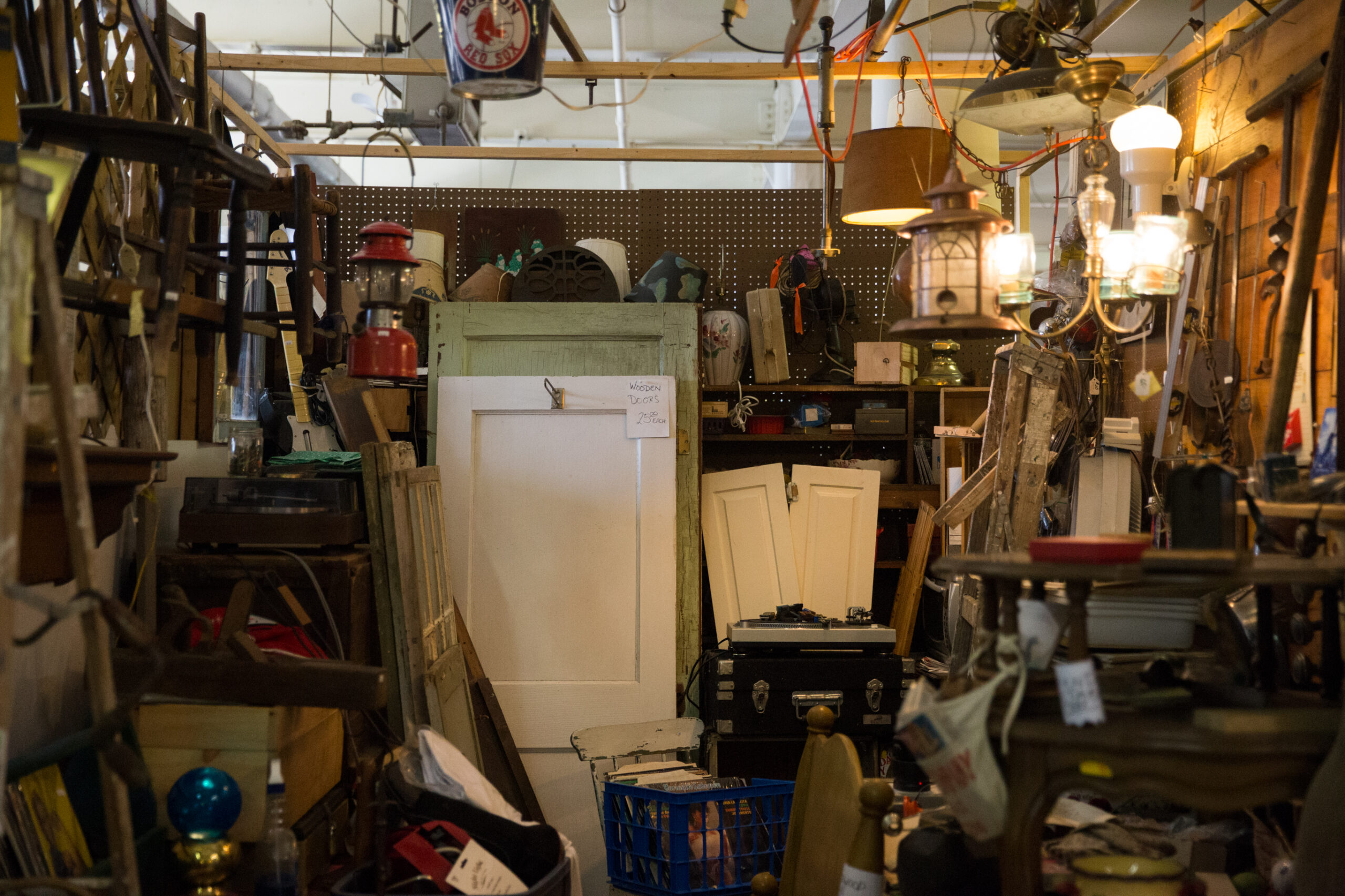Relics for sale, in a modern age
Vendors at the Waterfront Flea Market relish in their trade. Others, maybe not so much.
May 9, 2018
 Ann Basu
Ann Basu
Flea markets are big in Maine. In the summer, they dot vacant lots along Route 1, some consisting of stalls, others akin to a tailgate, vendors selling out of their truck beds. There are also chic indoor flea markets, like the Portland Flea-For-All, whose high-end collection of vintage and artisan pieces matches Portland’s quirky, hip and increasingly pricey vibe.
The Waterfront Flea Market defies categorization. It’s indoors, year-round, with no particular curatorial theme. Row after row of stalls are completely filled, some with a specialty (dolls, baseball cards), but most with a mish-mash of tchotchkes, furniture, toys, ceramic and books. Some items look worn and well-used, but others could be brand new.
A soft jazz tune flows out of overhead speakers as I wander through the rows of closely packed stalls even more packed with stuff. It’s a bit daunting: it can be hard to tell where one stall ends and another begins, and because the booths don’t move between market days, vendors can easily keep adding to their stock. The space definitely seems bigger than that where the winter market is housed, though I’m not sure if it is.
Jack, sporting a Stetson hat and a white beard almost as long as his shoulder-length hair, has a booth in the back corner, recognizable by its disorder. He said he’s tried several times to clean up a little bit and make it more “accessible,” but he keeps adding new items and it just becomes messy again. Ann Basu
Ann Basu
“Each booth reflects a little bit of how the person is. If you look at my booth,” he said as we walk into his booth, “I’m not one of those people who will accessorize. This is my booth. Welcome to it.”
Jack’s mish-mash includes ceramic teapots, a couple of doors and lamps and a wooden bed frame that he’s particularly proud to have snagged. “Nothing really extravagant,” he said. He doesn’t have a particular theme because there are no real collectors anymore. “It’s a hit or miss type of thing,” he lamented.
There are definitely fewer people here than next door at the winter market. Most of the people I see walking around are doing just that—walking around, looking at the items as if they were in a museum. That’s part of the novelty of a flea market, and part of the reason to go. When I asked Jack what made this market unique from other flea markets, he answered profoundly, and correctly, “Every place is unique because nobody has the same stuff. That’s what’s unique about them.”
But few people are buying here, today or any day, since online sales are increasingly surpassing in-person exchanges in stores and markets like this one. Sylvia Rose runs a stall entirely dedicated to dolls and their accessories, and she has noticed a change over the 14 or so years she’s been in this flea market.
“Well of course the flea markets aren’t what they used to be. Antiques have taken a nosedive, and particularly dolls,” she said. “They’re not as well received as they used to be.”
She’s been “dealing in dolls” for over 45 years and used to be a traveling saleswoman throughout New England. The constant packing up and moving became unsustainable, so she set up shop here at Fort Andross. Dozens and dozens of dolls, in all shapes and sizes, fill Sylvia’s shelves, along with their accoutrements. Sylvia perches in the middle, where she can keep an eye on the dolls, ready to chat up anyone who shares her passion.
“There still are collectors, adult collectors, who love dolls like I do. And they collect and come and we talk about them, and maybe they’ll buy one and maybe they won’t,” she said. “But it’s OK.”
Neither Sylvia nor Jack is in it for the money anymore. They, like many vendors at markets around the state, find value in the social interactions with buyers and other sellers—the communal aspect that draws people off the highway and into crowds of stalls and tables—and that’s what they stick around for.
“I may be from the old school, but I will not go online to sell. I’ve been told that I’m losing money. I don’t care … I’d rather deal with the customers like this,” Jack said. “I think that’s half of the thing.”
“I love meeting new people, and what’s more fun than sitting and talking with people who have the same interests you do?” said Sylvia.
Both the winter market and the flea market emphasize community, but in different ways. While the flea market finds much of its appeal within, among the vendors, the winter market’s connection to a wider ethos of Maine agriculture and localism pervades and draws people in.
The winter market’s success has actually helped the flea market, too, Sylvia noted.
“I think that having the farmer’s market next door helps, brings in people who have lived in the area all their lives and never knew we were here until they went to the farmers’ market and saw us,” she said.
When that happens, it’s just a happy coincidence, and maybe they’ll get a sale out of it. At this point, Sylvia and Jack are just having fun. Jack likes to sit in the market and play guitar with his friend Tom, and “sell something in the meantime.” Vendors support one another.
“The people here are friendly,” said Sylvia. “It’s like a big family. They’re honest.”
She paused.
“Mostly.”

Comments
Before submitting a comment, please review our comment policy. Some key points from the policy: